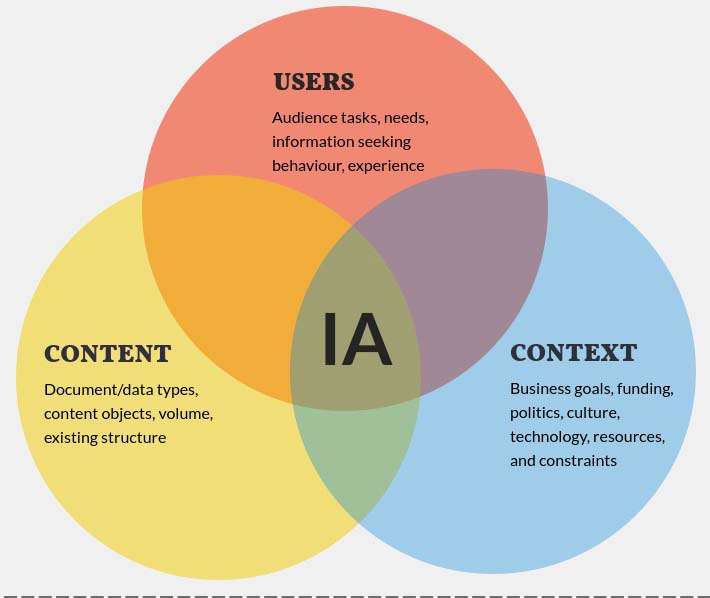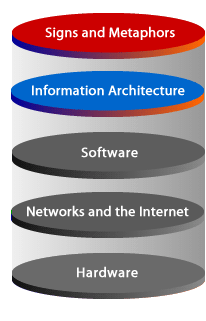| Lesson 4 | Information Architecture |
| Objective | Explain how Information Architecture is used to Organize Design Information |
Information Architecture is used to Organize Design Information
- Information Architecture The second layer of the Web Interaction Model is Information Architecture, which includes the Web site's organizing structure and navigation system. Information architecture refers to the organization of information on a website. It involves creating a structure that is easy to understand and navigate for users. The information architecture of a website is typically made up of several components, including the homepage, category pages, subcategory pages, and product pages. The primary goal of information architecture is to make it easy for users to find the information they are looking for. This is achieved by organizing the content in a logical and intuitive manner. When the information is easy to find, users are more likely to stay on the website and engage with the content. It also provides systems for structuring and finding information, allowing users to interpret the designer's meaning, as shown in the diagram below.


| Signs and Metaphors | Images, icons, colors, sounds, implied comparisons. |
| Information Architecture | Structure, navigation |
| Third layer, Software | Software combines function and design, allowing the user to view and interact with the first two layers. Software includes languages, applications, databases, and bundled software solutions. |
Information Architecture WWW
Information Architecture Models and examples
Information architecture modeling elements
- Site hierarchy: Use hubs and visual layouts to establish visual hierarchy
- Security: Data governance, administration and editing privileges
- Taxonomy: Record management, compliance requirements
Information Architecture exists wherever information is compiled for access and use. It establishes conventions to structure and organize information in meaningful ways. For example, the Information Architecture of a book provides a structure for content that includes chapters, paragraphs, sentences, and footnotes. Books also offer navigational elements such as a table of contents, page numbers, chapter titles, and paragraph breaks. The pathway through a book is generally linear and sequential, although an index allows you to find information nonsequentially. One simple way to think about Information Architecture is to consider a phone book. Color is used as a meaningful sign to signify residential (white pages) information and business (yellow pages) information; information is organized alphabetically, by name for residents or by type of service or product for a business. The restaurant section may have an alternate Information Architecture that lists restaurants alphabetically by type of cuisine, for example, Chinese, Middle Eastern, and vegetarian.
What are SILO's?
SILO's are an organizational structure that is commonly used in website design. The term SILO refers to a group of related pages that are organized around a specific topic or theme. Each SILO typically contains a main page, as well as several subpages that are related to the main topic.
The primary goal of SILO's is to improve the user experience by making it easier to find the information they are looking for. When the content is organized into specific themes or topics, users are more likely to find what they are looking for quickly and easily.
How Information Architecture Ties into SILO's
The information architecture of a website is closely tied to the SILO structure of a website. In order to create effective SILO's, it is important to have a clear understanding of the information architecture of the website.
The first step in creating effective SILO's is to identify the main themes or topics that the website will cover. This will help to determine the structure of the website and the organization of the content.
Once the main themes or topics have been identified, the next step is to create a hierarchy of pages that are related to each theme or topic. This hierarchy should be based on the information architecture of the website, and should be designed to make it easy for users to find the information they are looking for.
It is important to note that the SILO structure should not be created in isolation from the information architecture of the website. Instead, the two should be closely integrated to create a seamless user experience.
Benefits of an Effective SILO Structure
An effective SILO structure can provide several benefits for website owners. One of the primary benefits is improved user experience. When the content is organized into specific themes or topics, users are more likely to find what they are looking for quickly and easily. Another benefit of an effective SILO structure is improved search engine rankings. When the content is organized into specific themes or topics, it is easier for search engines to understand the content of the website. This can lead to improved search engine rankings and increased visibility for the website.
Conclusion
In conclusion, the information architecture of a website is closely tied to the SILO structure of a website. In order to create effective SILO's, it is important to have a clear understanding of the information architecture of the website. An effective SILO structure can provide several benefits for website owners, including improved user experience and improved search engine rankings. By creating a seamless user experience and organizing content in a logical and intuitive manner- Content structure on the Web Information Architecture for the Web is different from paper-based Information Architecture. The structure of information is highly customizable, based on users's needs. For commercial sites, you should always consider how information is organized. Information with poor structure can result in loss of sales or confidence in the company. Effective structure and navigational tools are of utmost importance. When a user cannot find the information he or she seeks frustration may lead the user to exit the site altogether.